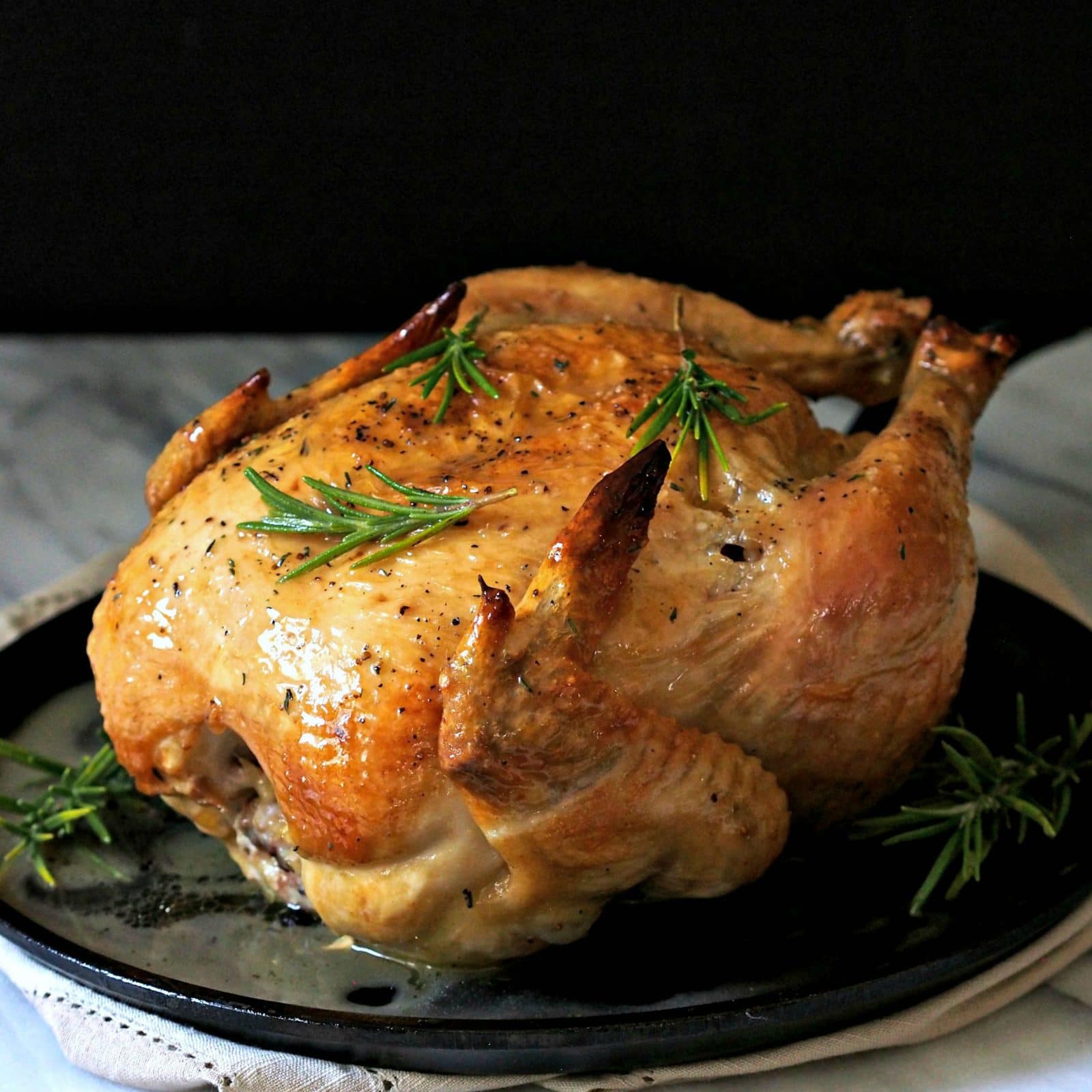Roast Chicken Recipe: Forget takeout! This isn’t your grandma’s roast chicken (unless your grandma was a culinary genius, then maybe it is). We’re diving deep into the art of perfectly roasted chicken, from choosing the bird to mastering crispy skin and killer gravy. We’ll cover everything from classic techniques to some seriously cool variations, ensuring your next roast chicken dinner is legendary.
We’ll explore the rich history of roast chicken, touching on its global appeal and cultural variations. Then, we’ll walk you through selecting the perfect chicken, prepping it like a pro, and experimenting with different marinades and seasonings. Get ready to master roasting techniques, whether you’re using a conventional oven, a convection oven, or even a rotisserie. We’ll also cover troubleshooting common issues and suggest some amazing side dishes to complete your culinary masterpiece.
Roast Chicken: A Culinary Classic
Roast chicken, a seemingly simple dish, boasts a rich history and cultural significance spanning centuries. From ancient Roman feasts to modern-day family dinners, it remains a beloved staple. This versatile dish adapts beautifully to diverse culinary traditions, with variations in seasoning, cooking methods, and accompanying sides reflecting regional preferences and cultural influences.
A Brief History and Cultural Variations of Roast Chicken
The practice of roasting poultry dates back to antiquity. Evidence suggests that various cultures, including ancient Egyptians and Greeks, enjoyed roasted birds. The Romans, known for their elaborate feasts, elevated roast chicken to a culinary art form. Over time, different regions developed unique approaches to roasting chicken, incorporating local herbs, spices, and cooking techniques. For example, French cuisine emphasizes delicate herb-based preparations, while Mediterranean recipes often feature vibrant citrus and olive oil.
In many cultures, roast chicken symbolizes celebration, family gatherings, and comforting tradition.
Finish your research with information from craigs list fort collins.
The Appeal of Roast Chicken as Comfort Food, Roast Chicken Recipe
Roast chicken’s enduring appeal stems from its inherent qualities as comfort food. The aroma of roasting chicken evokes feelings of warmth and nostalgia, connecting us to cherished memories and familiar flavors. The juicy, tender meat, crispy skin, and satisfying simplicity make it a universally appealing dish. Its adaptability also contributes to its comforting nature – it can be prepared simply or elevated with complex flavor profiles to suit any palate.
Choosing and Preparing the Chicken
Selecting the right chicken and preparing it properly are crucial steps for achieving a perfectly roasted bird. This section details the process of choosing a chicken, thawing it safely, and preparing it for roasting. We’ll also provide a guide to roasting times based on chicken size.
Selecting and Thawing a Chicken
Look for a chicken with firm, plump flesh, and clear, bright eyes (if still intact). The skin should be smooth and free from blemishes or discoloration. To safely thaw a frozen chicken, transfer it from the freezer to the refrigerator 24 hours for every 5 pounds of chicken. Alternatively, you can thaw it in a cold water bath, changing the water every 30 minutes.
Never thaw a chicken at room temperature.
Cleaning and Preparing the Chicken
Rinse the chicken thoroughly under cold running water, inside and out. Pat it dry with paper towels. Remove any giblets from the cavity. You can truss the chicken (tie the legs and wings together) for even cooking and better presentation, but it’s not strictly necessary.
Roasting Times Based on Chicken Size
| Chicken Weight (lbs) | Roasting Time (approx.) | Oven Temperature (°F) | Notes |
|---|---|---|---|
| 3-4 | 1 hour 15 minutes – 1 hour 30 minutes | 400 | Smaller chickens cook faster. |
| 4-5 | 1 hour 30 minutes – 1 hour 45 minutes | 375 | Medium-sized chickens require a slightly lower temperature. |
| 5-6 | 1 hour 45 minutes – 2 hours | 350 | Larger chickens need more time at a lower temperature. |
| 6+ | 2 hours + | 325 | Adjust cooking time as needed, depending on the size and oven. |
Marinades and Seasonings
Flavorful marinades and seasonings elevate roast chicken to new heights. Here are three distinct marinade recipes and tips for achieving optimal flavor.
Marinade Recipes
These marinades can be used for at least 4 hours or overnight for maximum flavor infusion.
- Herb-Based Marinade: 1/4 cup olive oil, 2 tablespoons chopped fresh rosemary, 2 tablespoons chopped fresh thyme, 1 tablespoon lemon juice, 1 clove garlic, minced, salt and pepper to taste.
- Citrus-Based Marinade: 1/4 cup orange juice, 1/4 cup lime juice, 2 tablespoons olive oil, 1 teaspoon grated orange zest, 1 teaspoon grated lime zest, salt and pepper to taste.
- Spice-Based Marinade: 1/4 cup olive oil, 1 tablespoon paprika, 1 teaspoon cumin, 1 teaspoon garlic powder, 1/2 teaspoon onion powder, 1/2 teaspoon cayenne pepper (optional), salt and pepper to taste.
Dry Brining
Dry brining involves generously seasoning the chicken with salt and letting it sit uncovered in the refrigerator for several hours or overnight. This method helps to retain moisture and enhance flavor.
Seasoning the Chicken
Source: bonappetit.com
Season the chicken cavity with salt, pepper, and any desired herbs. Rub the skin generously with salt, pepper, and your chosen herbs or spices for maximum flavor and crispy skin.
Common Herbs and Spices
- Rosemary
- Thyme
- Sage
- Oregano
- Paprika
- Garlic Powder
- Onion Powder
- Cumin
- Black Pepper
Roasting Methods and Techniques
Different roasting methods yield varying results. Understanding the nuances of each method, along with techniques for achieving crispy skin and checking for doneness, is key to roasting success.
Conventional Oven vs. Convection Oven vs. Rotisserie
Conventional ovens cook evenly with radiant heat, while convection ovens use a fan to circulate hot air, resulting in faster and more even cooking. Rotisseries cook the chicken evenly by rotating it over a heat source, producing exceptionally crispy skin.
Achieving Crispy Skin
High heat helps render the fat and crisp the skin. Basting the chicken with pan drippings during cooking also contributes to crispy skin. Patting the chicken dry before roasting is also essential for achieving crispy skin.
Checking for Doneness
Use a meat thermometer inserted into the thickest part of the thigh (avoiding the bone) to ensure the chicken reaches an internal temperature of 165°F (74°C). The juices should run clear when pierced with a fork.
Roasting Temperatures
Higher temperatures (400-425°F) result in crispier skin but may lead to drier meat if overcooked. Lower temperatures (325-350°F) ensure more even cooking and juicier meat, but may take longer to achieve crispy skin.
Accompaniments and Serving Suggestions
Roast chicken pairs beautifully with a variety of side dishes and sauces. Here are some classic pairings and creative serving suggestions.
Classic Side Dishes
- Roasted Potatoes
- Green Beans
- Mashed Potatoes
- Stuffing
- Gravy
Making Gravy
Deglaze the roasting pan with chicken broth or water, scraping up any browned bits. Simmer until slightly thickened. Strain and serve.
Leftover Roast Chicken
Leftover roast chicken can be used in salads, sandwiches, soups, or enchiladas. It can also be shredded and used as a filling for tacos or quesadillas.
Sauces for Roast Chicken
| Sauce | Description | Ingredients | Notes |
|---|---|---|---|
| Pan Gravy | Classic gravy made from chicken pan drippings. | Chicken drippings, broth, flour | Simple and flavorful. |
| Lemon Herb Sauce | Bright and refreshing sauce with herbs. | Lemon juice, herbs, butter | Pairs well with roasted vegetables. |
| Creamy Mushroom Sauce | Rich and savory sauce with mushrooms. | Mushrooms, cream, butter, herbs | A luxurious accompaniment. |
Troubleshooting Common Problems
Even experienced cooks encounter challenges when roasting chicken. Understanding common problems and their solutions can prevent disappointments.
Common Problems and Solutions
Dry Meat: This often results from overcooking or insufficient basting. Use a meat thermometer to ensure proper doneness and baste regularly. Uneven Cooking: This can be due to uneven oven temperature or overcrowding the pan. Use an oven thermometer to monitor temperature and ensure adequate space between chicken pieces. Burnt Skin: This happens when the oven temperature is too high or the chicken is placed too close to the heat source.
Lower the oven temperature or adjust the rack position.
Preventing Mistakes
Using a meat thermometer is crucial for ensuring the chicken is cooked through without overcooking. Allowing adequate space between chicken pieces in the roasting pan promotes even cooking. Preheating the oven to the correct temperature is also essential.
Importance of an Oven Thermometer
Oven temperatures can fluctuate, leading to inconsistent cooking results. An oven thermometer provides accurate temperature readings, allowing for adjustments as needed to ensure proper cooking.
Variations and Advanced Techniques
Beyond the basics, there are many variations and advanced techniques to explore.
Spatchcock Chicken
Spatchcocking involves removing the backbone of the chicken, flattening it, and roasting it. This method results in faster cooking and crispier skin.
Roasting Rack
Using a roasting rack elevates the chicken, allowing for even heat circulation and crispier skin. The fat renders more effectively, leading to a juicier result.
Stuffed Roast Chicken
Stuffing the chicken cavity with bread, herbs, and vegetables adds flavor and complexity. Be mindful of stuffing the chicken adequately without overfilling to prevent uneven cooking.
Visual Description of a Perfectly Roasted Chicken
A perfectly roasted chicken boasts golden-brown, crispy skin with a slight sheen. The meat is juicy, tender, and easily pulls away from the bone. The internal temperature reaches 165°F (74°C). The aroma is rich and inviting, a blend of roasted poultry, herbs, and spices. The overall presentation is appealing, with even browning and a slight crispiness to the skin.
End of Discussion: Roast Chicken Recipe

Source: simplysated.com
So, there you have it – your comprehensive guide to conquering the art of roast chicken. Whether you’re a seasoned chef or a kitchen newbie, this recipe will elevate your chicken game to the next level. Remember, practice makes perfect, so don’t be afraid to experiment with different flavors and techniques. Soon, you’ll be the roast chicken whisperer of your friend group, impressing everyone with your perfectly golden-brown, juicy, and flavorful bird.
Now go forth and roast!



